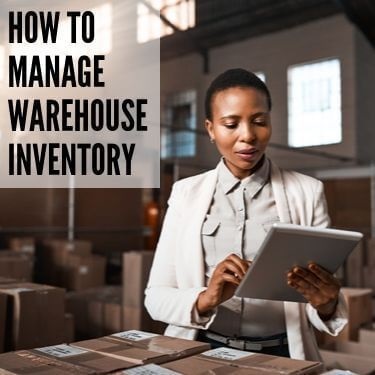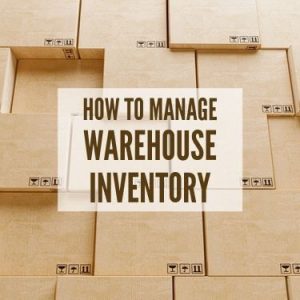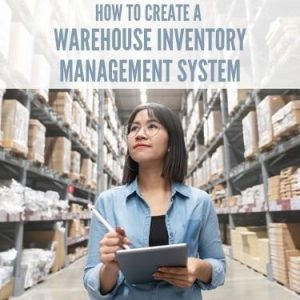
 Copy URL to Clipboard
Copy URL to Clipboard
You may be struggling with how to manage warehouse inventory for your logistics company and don’t know where to begin in order to rectify the issues.
A productive warehouse begins with knowing how to manage warehouse inventory. By using priority picking, reworking inefficient floorplans, adding labels to product inventory, implementing personal identification, and using quality control methods, it’s possible. Processes like priority picking, wave picking and cross docking can all help you figure out how manage warehouse inventory.
Table of Contents

If your logistics company is in a position where top inventory is coming in faster than it can be organized, that equals a bunch of missed opportunities.
However, if you can get things turned around, this is actually a pretty good problem to have. It means business is booming, which is what any company wants. Once you can figure out a means of organizing and managing inventory, the warehouse becomes less of a pain point.
With some help from the following tips, you can pinpoint the areas in which you’re lacking and your logistics company may start with one or two of these techniques. If a few tweaks to your warehouse organization is enough to boost productivity and order efficiency, that is excellent.
Other warehouses may need more help, which is fine. The sooner you address inventory control in a disorganized warehouse, the faster you can proactively fix the issue. This will get products moving out the door and into the hands of customers in no time.
GET A QUOTE
Let’s get into the various methods for how to manage warehouse inventory now.
Let's start with pick and pack fulfillment. When orders arrive to the warehouse, they go into master cartons. The warehouse employees pick the items needed to fulfill an order from the carton. Then they pack it up and ship it out.
That’s one method your logistics company might want to try if you haven’t already. There are plenty of other picking options to consider as well, which will affect how to organize inventory in the warehouse. These are:
You can select your colors several different ways. Perhaps you ship edible and non-edible items to customers. Since edible items often have sensitive expiration dates, these need to go out first. They would be assigned a certain color so employees know to move them out the door fast. Non-edible items would be a different color that signifies lesser urgency.
All aspects of receiving, organizing, and shipping an order are included as part of wave picking. The process starts at the order lines and continues until the product is packed and out the door.
Each warehouse employee may do as little as two and as many as eight waves in a regular shift. The duration of the waves can last an hour on the shorter end and four hours on the longer end. For more information about the role picking and packing plays, take a look at our Benefits of Pick and Pack article.
Cross-docking services can save money for your company. As one vehicle receives an order, it goes right to another truck. The orders that do arrive to the warehouse are often consolidated or pre-sorted. That makes the lives of the warehouse employees easier. They can then just prep the items for shipping.
Finding the right products to put in an order should not be chaotic. However, sometimes you and other members of the staff forget to ensure the orders are labeled and packaged. When these same orders hit the warehouse floor, confusion can take over.
What’s in the box? Who should it go to? The warehouse employee has to ask around until they get the answer. This can waste a lot of time if it happens even irregularly.
From the moment a product enters your logistics facility, it should have a label on it. If it doesn’t, the product order progress should be paused until someone can apply the right labeling.
To manage a slew of products that all arrive at once, it might be worth considering investing in a labeling system for your company.
These systems include:

What does the floorplan look like at your warehouse? Has the warehouse management process been the same since your logistics company opened? Perhaps with the advent of newer technology, you’ve made some alterations to the floorplan. It could have been years since you or another member of your staff have reviewed it.
Before you begin implementing any of the warehouse inventory management tips and techniques we’ve mentioned, you need to check your floorplan.
If you’re adding new technologies to your warehouse or changing how your employees do their jobs, you must make sure you have the capacity to do so. Not only do you need a warehouse of a certain size, but you need it to be organized as well.
There are several ways an insufficient floorplan can hurt inventory organization. The first of these is having too many warehouse employees milling about. Everyone should have a task or several on their to-do lists to avoid taking up warehouse floor space unnecessarily.
If some of your employees are packing items a certain way and another portion of your employees are doing things a different way, this is problematic. The employees have a higher chance of getting in each other’s ways, and everyone loses then.
Without a well-functioning warehouse floorplan, it’s hard to track employees. Who’s doing what, when, and for how long? You can’t tell because there’s so much going on with your warehouse.
If your current warehouse floorplan isn’t working as is, it’s time to scrap it, start over and figure out how to manage your warehouse. Think about the technologies and systems you’re using now as you draw up this new floorplan. Also, consider what kinds of techniques you might implement in the future. Make way for these as well if at all possible.
Once you come up with a floorplan you and your team are happy with, your work isn’t totally done. At least once a year, you should review the current floorplan. If you can do this every six months or quarterly, that’s even better. If you’re making major changes to the procedures of your warehouse, then that’s another great time to review your floorplan.
The goals of changing the floorplan are:
Another consideration you might make for your warehouse inventory management is to increase the amount of receiving space you have. This would mean another alteration to the warehouse.
The warehouse receiving process is an incredibly important one. This is where your warehouse receives the orders customers have placed. Failing to have an adequate warehouse receiving process could lead to several issues:
These item errors fail to get the order in the hands of the customer as promised. Not only that, but you could strain your working relationships with vendors, retailers, and other clients. You also hurt the financial bottom line for both your own company and that of your clients.
Many of the above issues can be reduced or even eliminated by creating more space for incoming receiving items. Insufficient working space means warehouse employees are constantly elbowing one another for room. Larger orders take up too much space that isn’t available.
You might want to get an office area built to solve this issue. Alternately, if your warehouse has any spare room that’s large enough for a receiving area, you could use this.
Besides the size of your receiving area, you want to make sure the following are all part of your receiving process:
If you're constantly struggling with warehouse management issues, such as an inefficient floorplan for lack of receiving space, it might be time to outsource your warehouse operations. Take a look at our Benefits of Outsourcing Warehouse Operations article for more information on why this might be the best option for you.
In the section about floorplan efficiency, we mentioned the importance of ensuring only authorized warehouse workers are on the floor. While an organized floorplan is the first step in employee management, you have further options like using personal identification numbers.
This is a form of tracking employees so only those who are allowed on the floor are there. Personal identification is especially important at this stage considering all the other warehouse changes you’re implementing. After all, as we mentioned before, having too many employees in the same area creates congestion. They get in the way of one another, slowing down the ones who are trying to work. This means productivity and efficiency both take a hit.
You might want to introduce security procedures to keep the floor staffed with relevant employees. This lets the warehouse staff focus on their job uninterrupted.
Still asking how to manage your warehouse inventory? Another tactic we recommend is switching between movable and fixed tracking.
Movable tracking is the management of those pallets, units, and items that go through your supply chain. Such items typically shift through your warehouse before reaching their destination.
Then there’s fixed assets tracking. This lets you manage assets location, who has them, and when the assets are due back. This tracking can go throughout the warehouse.
Both moveable and fixed tracking have their place in a warehouse management system. There’s no need to choose one over the other. Rather, by switching between the two as necessary, you can reduce confusion, improve order accuracy, and boost production on the warehouse floor.
GET A QUOTE
Our last tactic for managing warehouse inventory is to implement quality control measures. If your logistics company doesn’t already have some form of quality control (or QC), it’s important to change that immediately.
Most employees make mistakes at some point. A QC system can catch errors while the product is still in the warehouse. This allows you to maintain your sterling reputation as a trusted shipper to your customers. Speaking of, your customers are happier, too, since they always get what they ordered the first time.
A QC system might inspect incoming orders for damage. Outgoing orders should be checked as well. You want to ensure each order is correctly filled and has the proper quantity. Double-check the stock-keeping unit or SKU as well. Finally, make sure the outgoing package isn’t damaged in any way.
This may be an extra job for someone at your logistics company, but it’s one that’s absolutely worth it. After all, if your company makes a shipping mistake, it’s up to you to fix it. That means paying for the order to be shipped back. Then you have to use time and materials to repackage the order and send it out again.
GET A QUOTE

The above steps are certainly plentiful, and many of these solutions are not overnight fixes. They’ll take time, dedication, and careful review to work for your logistics company. However, that doesn’t mean managing your warehouse inventory should go on the backburner. Here are several reasons warehouse inventory management solutions are important for the short and long-term success of your company:
If your products are following a FIFO inventory model, take a look at our FIFO Procedures for Warehousing article.

If you’re ready to clean up, you may wonder how to organize inventory in a warehouse.
Today, many modern logistics companies rely on a warehouse inventory management app. This is sometimes referred to as a warehouse inventory management system.
These systems give you real-time data updates about incoming and outgoing inventory on any given day. The reduction in lag ensures your readings are always accurate. Having this data lets you make smart, impactful decisions regarding your warehouse floor employees.
A warehouse management system, often abbreviated to WMS, can sometimes be part of a bigger system as inventory management software could give your business a boost. This is called the Enterprise Resource Planning system or ERP. An ERP system is software-based. It can be formulated for smaller warehouses or bigger ones depending on your needs.
According to ERP system data from 2016, here are the reasons a company might consider an ERP system:
Not sure how to manage warehouse operations using WMS and/or ERP systems? Let’s break down the process.
GET A QUOTE
The first stage of setting up your warehouse inventory management system is to select a vendor to work with. First, you have to decide if you want just a WMS system or one that’s part of a greater ERP system.
Once you’ve chosen the option that’s best for your logistics company, it’s time to begin searching vendors.
Today’s software vendors offer many exemplary features that make organizing your warehouse a breeze. These include voice recognition, cloud-based data, and even radio frequency identification or RFID.
Don’t be too distracted by all these flashy features. You want to keep the following in mind as you narrow down your vendors:

Once you select a vendor, it’s time to move onto phase two. This is the stage for project planning. The software company you’re working with may request information such as inventory, materials, and specs and data on your warehouse. This is to help them create a customized solution suited to your company. Provide this information readily to keep everything moving smoothly.

When the vendor processes all the necessary information and you finalize your payment, you can begin using the WMS and/or ERP software. As new items arrive at the warehouse, you or another employee will have to add each one to your system. This can take extra time at first, but a WMS system will be more time-efficient in other ways later.
Adding inventory to the system might require you to know the rack and storage bin dimensions. You might also have to include the weight and size of each new item that comes to the warehouse.
WMS software only a good solution if you keep it updated. Not doing so can lead to the same gaps and disappearances in inventory you experienced before using the software.
GET A QUOTE
Next, you enter the review period. Give your staff some time to learn and get used to the new system. Spend some time with the software yourself.
While we don’t recommend foregoing WMS software altogether, sometimes you find out the hard way that the first vendor you chose isn’t right for you. If that’s the case, then be honest about it. It’s better to take some time and spend more money to get a better fit than continue using a system that doesn’t suit your warehouse.
During the review period, you might be able to get your money back for your expense. If you can’t be refunded, at least you know now what you want out of WMS software for next time.

If implementing a warehouse management inventory system has been a challenge, you’re not the only one to think so. Many logistics companies like yours have found the experience to be fraught with difficulties.
Here is a list of some of the challenges you may encounter while improving inventory tracking:
Your warehouse may have busy seasons and those where it’s rather dead, especially if you have seasonal vendors. Other factors that can influence product demand are weather and even economical changes big or small.
The software systems you bought may not be as useful for inventory on a smaller scale, leaving you wondering if you wasted your money.
Sometimes products get broken on their way to the warehouse. In other cases, old pallets or boxes cause the damage. Although it can be expensive, you have to pay for new pallets if the nails are coming out or if you see planks that have cracked or worn down. Otherwise, you’ll have to shell out money to replace broken products again and again.
If you plan to have your warehouse floor staff use picking or other techniques, they must know how to do so. This requires a training period that instructs all employees on receiving, sorting, managing, and shipping products. This training can be time-consuming as well as expensive.
With new changes in place at the warehouse, redundancies may make themselves apparent. Failing to identify these can be costly. Too many employees will be doing the same thing, wasting both time and money.

If you’re facing any of the above-mentioned challenges, striving to overcome them is best. Being able to identify these challenges is the first step towards working through them. You’ll also need viable solutions, such as these:
If you’re just learning your WMS software, then a slow season can actually be a blessing. Since there’s fewer incoming products to put into the system, you and your fellow staff can get a feel for the software quickly. This way, once order frequency does pick up, using the software is easy.
What we do recommend is having two different organizational systems: one for the slower season and the other for the busier season. This way, warehouse employees aren’t sitting around twiddling their thumbs when it’s slow. They’re also not overwhelmed when work picks up.
From trucks to pallets, master containers, and everything in between, these all must be in working order. The newer and higher in quality, the better. It’s indeed true that replacing these things is by no means cheap. That said, the money you spend now will stretch out for years.
You can even save money. After all, with better receiving equipment, there’s fewer chances of product breakages. That means you don’t have to pay to replace damaged products nearly as often, if at all.
There’s no way to avoid training your employees on better warehouse inventory organization. What you can do is address concerns one by one.
It might be the time aspect of the training that you’re worried about. If that’s so, you might break up training sessions. Instead of doing two weeks straight of training, take three days a week over several weeks and train then.
As for spending money, that’s also pretty much unavoidable. You will need the best training materials for your employees, both the onboarding and current ones. This allows them to do their job to your expectations. Just know you make that money back as your warehouse employees handle orders with care to prevent breakages and inaccuracies.
You have to take a hard look at your current processes. Are there any redundancies you might have missed? If so, it’s time to get rid of them.
Each employee on the warehouse floor should have his or her own purpose. Some employees may work in tandem to get a job done, but duty overlap should not occur. If it does, it’s time to go back through your processes and figure out why that is. You should also find another task for the warehouse employee in the meantime.
GET A QUOTE
Let R+L Global Logistics set up how to manage your warehouse inventory. R+L Global’s retail fulfillent logistics services can make organizing your order supply chain far simpler than ever before.
R+L Global Logistics has WMS and ERP software to track your inventory levels, and up-to-date computer systems to manage what comes in and what goes out in real-time, providing accurate data.
Whether it’s project rollouts, remodel rollouts, and even expiration-sensitive products, the expertise of R+L Global Logistics can help you put together a warehouse inventory plan that works for you. Let us help you figure out how to manage warehouse inventory. Call 866-989-3082 today to find out how we can offer whatever solution you might need for your warehousing needs.
GET A QUOTE
